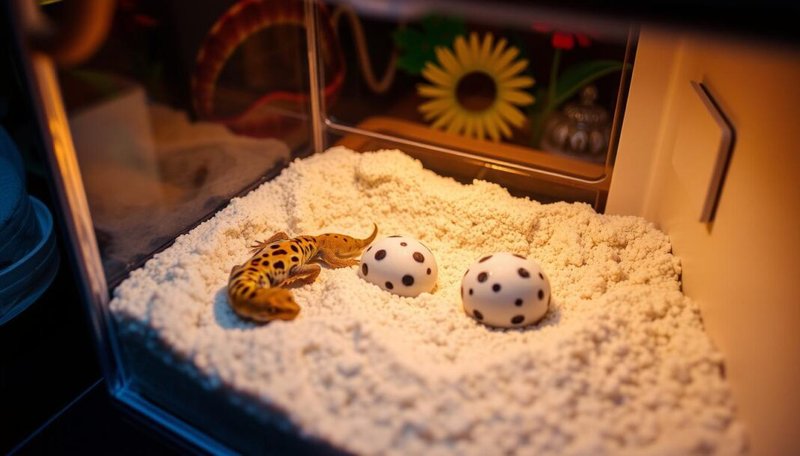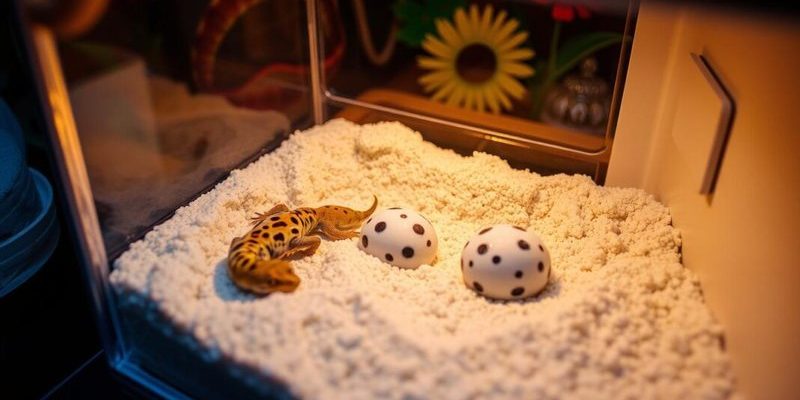
To kick things off, let’s think of the leopard gecko as a graceful dancer, flipping and twirling on the stage of your terrarium. You’ve got to set the stage just right. So, how do you get started with pairing these fascinating creatures? And once you do, what happens next? Let’s break it down step by step.
Understanding Leopard Gecko Breeding Behavior
Before you start pairing your leopard geckos, it’s essential to understand their breeding habits. Leopard geckos are typically individually solitary, but they do have a distinct mating season. Generally, this happens in the spring; the warmer temperatures and longer days signal them to get in the mood. You might notice your male gecko flaunting his colors and exhibiting a bit of a playful attitude—this is his way of showing off!
Once he’s ready, he’ll engage in a classic courtship dance. He may perform head-bobbing and tail-waving to catch the attention of a female. If she’s interested, she’ll respond with her own signals. It’s like a little dance-off; the chemistry here is real! However, if you see aggression or stress, don’t force the pairing. It’s crucial to keep an eye on their interactions to ensure they’re compatible.
Another thing to be aware of is the age and health of your geckos. Both should be at least 18 months old and in good health before breeding. A healthy couple has a better chance of producing robust hatchlings. So, take a moment to check their weights and skin conditions—healthy geckos are happier geckos!
Preparing the Breeding Environment
Creating the right environment is half the battle when breeding leopard geckos. You’re essentially creating a cozy love nest that’s perfect for romance. First, ensure you have a spacious, comfortable enclosure. A 20-gallon tank should suffice for a breeding pair. This gives them room to roam while keeping stress levels low.
Make sure to include plenty of hiding spots. Think of things like caves, logs, and plants—these are essential for giving them a sense of security. Hiding spots help reduce stress and create a comfortable environment for your female when she’s ready to lay eggs. You should also keep the temperature between 80°F and 90°F (27°C to 32°C) on the warm side and around 70°F to 75°F (21°C to 24°C) on the cool side. This balance mimics their natural habitat and keeps them happy.
Humidity plays a role too. While leopard geckos aren’t fans of high humidity, having a moist hide can help them when they’re pregnant. Consider adding a small dish of water or a damp substrate in one corner of the enclosure. Just be sure to monitor it, so it doesn’t become stagnant—keeping things fresh is key!
Choosing the Right Pairing
Selecting the right pair for breeding is crucial. You might be tempted to choose two beautiful geckos without considering their genetics. Remember, just like in the animal kingdom, genetics play a big role in the appearance and health of the hatchlings. If you’re looking to produce specific color morphs, be sure to research their genetics. This is where things can get tricky but also super exciting!
Here’s a quick breakdown of different morphs you might consider:
- Normals: The classic look you see most often.
- Albinos: A striking, light-colored version that’s captivating.
- Tangerines: Bright and vibrant, perfect for color enthusiasts.
- Bell or Tremper Albino: Each with unique patterns and colors.
Once you’ve picked your dream couple, it’s time to introduce them in the breeding enclosure. Monitor their interactions closely—if they seem to squabble, separate them for a bit before trying again. Sometimes, they just need a little warming up to each other. Creating a romantic atmosphere is all about patience!
Egg Laying: What to Expect
Now that you’ve successfully paired your geckos, it’s time for the female to lay her eggs. Typically, a female will lay one to two eggs at a time, with clutch sizes averaging around 2 to 4 eggs every few weeks. You’ll want to make sure she has a laying area—think of it like a special place just for her. A small container filled with moistened substrate like vermiculite or peat moss is perfect for this.
Keep an eye on her as the time approaches; she might seem restless or spend more time in her laying area. Once she lays the eggs, you’ll need to gently remove them and place them in an incubator. Here’s the thing: handling the eggs can be a bit daunting! Just be sure not to turn them. Eggs have an “up” side, and rotating them can mean trouble for the little ones developing inside.
Incubating Leopard Gecko Eggs
Incubation is the most crucial stage in a leopard gecko’s journey. The temperature you set for incubation can determine the gender of your hatchlings! Male geckos generally develop at warmer temperatures, while females thrive at cooler ones. Therefore, setting your incubator to around 82°F to 88°F (28°C to 31°C) is a good range to start with.
When placing the eggs in the incubator, try to keep them in the same position they were laid. Use a substrate like perlite or vermiculite to ensure proper moisture levels. It’s also important to monitor humidity levels—around 70% humidity is ideal. This helps keep the eggs from drying out.
Typically, eggs will take about 40 to 60 days to hatch, depending on conditions. You might notice tiny cracks or even some wiggling as the hatchlings work their way out. It’s like watching a little drama unfold right before your eyes!
Caring for Hatchlings
Once the eggs hatch, the real fun begins! Newly hatched leopard geckos are adorable, but they do require care. First off, you should separate them from one another to reduce stress and competition. A smaller enclosure for each baby will help them feel secure.
Feeding time comes next! Hatchlings can eat tiny insects like pinhead crickets or small mealworms. Just ensure the food is appropriately sized—too big, and it might scare them. You’ll also want to provide a shallow water dish. Keeping things clean is vital, so do regular spot cleaning.
Keep an eye out for any health issues, too. If a hatchling seems lethargic or isn’t eating, it’s time to consult a vet. Remember, you want your little geckos to thrive!
Final Thoughts on Breeding Leopard Geckos
Breeding leopard geckos can be an incredibly rewarding experience. From the careful pairing to watching those tiny hatchlings break out of their eggs, it’s a journey full of excitement and learning. Just remember, it takes patience and a commitment to their care and well-being.
You might have some bumps along the way, but don’t let that discourage you! Like any great adventure, every challenge comes with a unique lesson. Soon enough, you’ll not just be a gecko enthusiast but a proud gecko breeder. Enjoy the process, and happy breeding!

